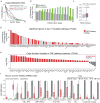Epigenetic restriction of extraembryonic lineages mirrors the somatic transition to cancer
- PMID: 28959968
- PMCID: PMC5789792
- DOI: 10.1038/nature23891
Epigenetic restriction of extraembryonic lineages mirrors the somatic transition to cancer
Abstract
In mammals, the canonical somatic DNA methylation landscape is established upon specification of the embryo proper and subsequently disrupted within many cancer types. However, the underlying mechanisms that direct this genome-scale transformation remain elusive, with no clear model for its systematic acquisition or potential developmental utility. Here, we analysed global remethylation from the mouse preimplantation embryo into the early epiblast and extraembryonic ectoderm. We show that these two states acquire highly divergent genomic distributions with substantial disruption of bimodal, CpG density-dependent methylation in the placental progenitor. The extraembryonic epigenome includes specific de novo methylation at hundreds of embryonically protected CpG island promoters, particularly those that are associated with key developmental regulators and are orthologously methylated across most human cancer types. Our data suggest that the evolutionary innovation of extraembryonic tissues may have required co-option of DNA methylation-based suppression as an alternative to regulation by Polycomb-group proteins, which coordinate embryonic germ-layer formation in response to extraembryonic cues. Moreover, we establish that this decision is made deterministically, downstream of promiscuously used-and frequently oncogenic-signalling pathways, via a novel combination of epigenetic cofactors. Methylation of developmental gene promoters during tumorigenesis may therefore reflect the misappropriation of an innate trajectory and the spontaneous reacquisition of a latent, developmentally encoded epigenetic landscape.
Figures














Comment in
-
Evidence for Converging DNA Methylation Pathways in Placenta and Cancer.Dev Cell. 2017 Nov 6;43(3):257-258. doi: 10.1016/j.devcel.2017.10.009. Dev Cell. 2017. PMID: 29112847
Similar articles
-
Epigenetic regulation of gene expression in porcine epiblast, hypoblast, trophectoderm and epiblast-derived neural progenitor cells.Epigenetics. 2011 Sep 1;6(9):1149-61. doi: 10.4161/epi.6.9.16954. Epub 2011 Sep 1. Epigenetics. 2011. PMID: 21975513
-
Dynamic integrated analysis of DNA methylation and gene expression profiles in in vivo and in vitro fertilized mouse post-implantation extraembryonic and placental tissues.Mol Hum Reprod. 2016 Jul;22(7):485-98. doi: 10.1093/molehr/gaw028. Epub 2016 Apr 18. Mol Hum Reprod. 2016. PMID: 27090932
-
Cell-context response to germ layer differentiation signals is predetermined by the epigenome in regionalized epiblast populations.Nat Commun. 2025 May 29;16(1):5000. doi: 10.1038/s41467-025-60348-6. Nat Commun. 2025. PMID: 40442089 Free PMC article.
-
Establishing three blastocyst lineages--then what?Biol Reprod. 2011 Apr;84(4):621-30. doi: 10.1095/biolreprod.110.085209. Epub 2010 Dec 1. Biol Reprod. 2011. PMID: 21123814 Review.
-
Cell fate regulation in early mammalian development.Phys Biol. 2012 Aug;9(4):045002. doi: 10.1088/1478-3975/9/4/045002. Epub 2012 Aug 7. Phys Biol. 2012. PMID: 22871593 Review.
Cited by
-
GBE1 Promotes Glioma Progression by Enhancing Aerobic Glycolysis through Inhibition of FBP1.Cancers (Basel). 2023 Mar 3;15(5):1594. doi: 10.3390/cancers15051594. Cancers (Basel). 2023. PMID: 36900384 Free PMC article.
-
Alterations in complement and coagulation pathways of human placentae subjected to in vitro fertilization and embryo transfer in the first trimester.Medicine (Baltimore). 2019 Nov;98(44):e17031. doi: 10.1097/MD.0000000000017031. Medicine (Baltimore). 2019. PMID: 31689742 Free PMC article.
-
Functional evaluation of transposable elements as enhancers in mouse embryonic and trophoblast stem cells.Elife. 2019 Apr 23;8:e44344. doi: 10.7554/eLife.44344. Elife. 2019. PMID: 31012843 Free PMC article.
-
Spatiotemporal transcriptomic maps of whole mouse embryos at the onset of organogenesis.Nat Genet. 2023 Jul;55(7):1176-1185. doi: 10.1038/s41588-023-01435-6. Epub 2023 Jul 6. Nat Genet. 2023. PMID: 37414952 Free PMC article.
-
ZFP57 regulation of transposable elements and gene expression within and beyond imprinted domains.Epigenetics Chromatin. 2019 Aug 9;12(1):49. doi: 10.1186/s13072-019-0295-4. Epigenetics Chromatin. 2019. PMID: 31399135 Free PMC article.
References
Publication types
MeSH terms
Grants and funding
LinkOut - more resources
Full Text Sources
Other Literature Sources
Molecular Biology Databases

